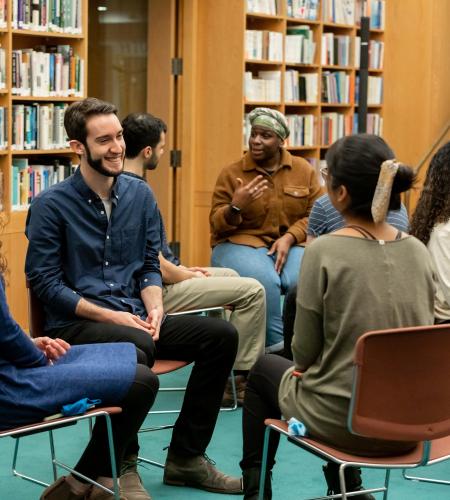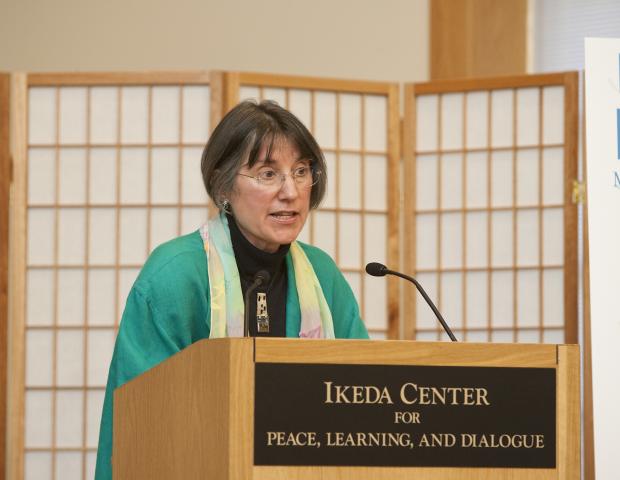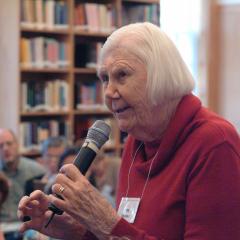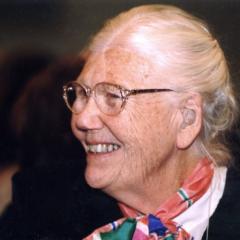Why is it that so many people don’t see peace work and peace education as a good thing? In fact, I’ve seen many people who get downright angry about it.
Sometimes this is a mystery to me, but I have some theories. First, I’m always careful to couch what I’m saying in language that people can understand. So if I detect up front that someone has a problem with the word “peace,” I might even hold back from using it at first. You need to “begin where they are,” as teachers and social workers say. You need to create that window of dialogue. Another of my thoughts is that we are all steeped so much in a culture of war that peace really does seem naïve to many people. Peace does seem like such a step out of what we are immersed in that it just seems like we could never go there. Part of the task for peace education is to break that misunderstanding down and to help people understand, for instance, that most of the time we are peaceful and that we can build on what’s already happening.
Essentially, the problem is a lack of visioning. We don’t envision future alternatives very easily. We tend to be stuck in our little paradigms. The overarching paradigm right now in the U.S. is for the kind of security that is defined as “peace through strength,” which says that the only way we can make peace is through military strength. Another option would be to take a more holistic view of peace making or peace building, taking into account structural issues such as global poverty and the very real need for human security, as Boulding, Ikeda, and others point out. This perspective takes much more of a values- and ethics-based look at what we consider basic human needs.
Among the misperceptions about the peace movement is that peace people are essentially passive in the face of our greatest challenges, and even in the face of evil.
That’s a really important misperception. People who are thinking about and studying nonviolence are sometimes concerned about the use of the term nonviolence since it seems to imply passivity. I like the term active nonviolence. When you are dealing with active nonviolence you are confronting the oppressive structure and those who are complicit in it. And you withdraw support for those in power in a particular situation when those in power, for example, deny human rights and dignity.
King and those in the Civil Rights movement, as well Gandhi, were very clear about the need for active nonviolence. But they were also clear that actions alone are not enough. On the other hand there are a lot of people out there doing purely tactical civil disobedience of the kind promoted by Gene Sharp (1) and others. But I prefer the approach of King and Gandhi, who say that maintaining a relationship with the other party—even when that party is an oppressor—is still of the utmost importance. You want justice, but your goal is still reconciliation. So, our resistance is not against people but against the problem.
As Bernard Lafayette (2) says, you need to know your “enemy” better than they know themselves. This task includes maintaining a faith in that kernel of morality or truth within them. This way, you can contribute to their transformation. There definitely is a spiritual component to the work. Some, like Gene Sharp, argue that you can just do strategic nonviolence, without attention to these spiritual factors. That’s true to an extent, and it has toppled regimes, but it doesn’t get to the core need for human transformation. After all, lasting change is both created and maintained by people.
This reminds me of another of King’s metaphors. He said we have inherited a large house, all of us together—the oppressor and the oppressed. This metaphor of the house suggests we are a family.
The metaphor of the house tells us that we have to get along. You don’t have to agree, but you have to understand. Understanding is the key. It’s not that you will absolutely get somebody to see your point of view, but there has to be some kind of sense that you are going to understand one another, at least on some level.
Certainly, the great majority of family members, even when they disagree, would not resort to violence against one another. Are there other metaphors you like for peace and peace building?
One that I like is that of a large tree—the tree of life. The tree stands tall and takes in all it needs from the world around it and gives back shade, rest, and beauty. It nurtures. And if you look at the inner rings of a large tree, each one shows what happened in a particular year. We all have our rings. Some years we have drought, some years we have abundance, and we weather all these changes. The tree doesn’t ask much, except some nurturing and that it not be cut down! For me, the image of the tree embodies multiple aspects of what are known as the “four Cs of peacemaking”: care, connection, compassion, and concern.
You are the biographer of the venerable peace researcher and organizer Elise Boulding. What is important to know about Elise and her work?
She was remarkable for her ability to vision and for her “can-do” spirit. Both of these qualities were rooted in her immediate experiences and informed by her deep sense of spirituality and commitment to making the world a better place. She was among the founders of no less then three movements in research, scholarship, and activism. First is Women’s Studies, which grew out of her dissertation work. Next is Peace Studies, which for her is a very interdisciplinary field. Third is Futures Studies, which is less well known. For Elise, all of these are integrated. For example, she explicitly built on her work in women’s studies to develop her pioneering work on women and peacemaking. No part of her work—or life—has been differentiated from another part.
It’s also important to note that Elise has been a lifelong learner. Amazingly she didn’t really pursue a formal academic career until she was in her mid 40s. Her commitment to learning was nurtured by her early family experiences, and it continues to this day. In all the roles of her life—as mother, Quaker, sociologist, activist, and even as retiree—Elise has always formed communities of learning: some small, some big. Her way of living life to the fullest has been a real gift to those of us who know her.
What is the relationship between women and peace building?
It’s important when we talk about women and peace that we don’t end up essentializing them and make the assumption that women are inherently more peaceful, all the time, than men. We can’t jump to that conclusion. It’s important to understand that there have always been women who believed in and supported war. And, of course, women do send their sons off to fight. Whether some do so with severe reservations is unclear. More and more, particularly with the use of the technology and the Internet, we are learning that military families don’t always support governmental policy toward war. It’s easier now to make your wishes known. And there are many outspoken mothers, Cindy Sheehan being the most prominent recent example.
But I think people like Elise Boulding are talking about how women are raised in our culture—notwithstanding the debate about whether women are biologically inherently more peaceful. I think that psychologists and anthropologists pretty much agree that culture is a big influence on women’s mode of being. Boulding’s theory—and that of people like Sara Ruddick and some of the other feminists—is that women learn these peace-oriented skills, including mediation and negotiation, by being part of the underside; by learning the work—out of sight, out of mind—of nurturing, maintaining families, communicating. These activities, basically, are what keep the world going! Without nurturing, communicating, and peacemaking in families we’d be in a sorry state! So, I think the case can be made for men learning peacemaking skills, and I believe that men, more and more, are learning such skills.
What about women who are overtly militaristic?
There have been women warriors throughout history, of course. But in a patriarchal world the kind of peacemaking and peace building skills we’re talking about here have not been acknowledged for their beauty and strength. And women as well as men are part of the patriarchal system, and susceptible to its values. As we deconstruct some of this patriarchy, appreciation for peacemaking skills is rising – and I think we’ll get there. Maybe in my lifetime!
What is the essence of peace?
I have a definition that I came up with for this interview: The essence of peace is promoting harmony, equality, and justice within and among individuals, communities, nations, and the world. It means a world where full human potential for everyone is reached and there is equal access for the basic resources of life, for accessing information, for education, and for the ability to actively question those in power.
Why did you construct the definition in this way?
First of all, I was taking into account notions of justice, because peace without justice is not a lasting peace. I also wanted to look at peace as beginning with each of us. We each need to actively promote our own inner peace and then work outwards from there. Many of the ideas in my definition are among the core principles of Elise’s Cultures of Peace as well as of the Earth Charter, and they owe much to the contributions of all the wonderful people who have worked, and continue to work, on this critical project of peace building.
Notes
1. Gene Sharp is a scholar, theorist, and proponent of nonviolent struggle and political change. He founded the Albert Einstein Institute in Boston in 1983. According to Wikipedia, “Sharp’s best-known book, The Politics of Nonviolent Action (1973), provides a pragmatic political analysis of nonviolent action as a method for applying power in a conflict.” His book From Dictatorship to Democracy outlines hundreds of methods and techniques of nonviolent protest, intervention, and non-cooperation in oppressive societies. His work has been cited as an important influence in fights against dictatorships worldwide, especially in the recent “color revolutions” in places such as Yugoslavia and the Ukraine.
2. According to the website of Emory University, where (as of 2010) he is Distinguished Senior Scholar in Residence, “the Rev. Dr. Lafayette is a longtime civil rights activist, organizer, and an authority on nonviolent social change. He co-founded the Student Nonviolent Coordinating Committee (SNCC) in 1960, and he was a core leader of the civil rights movement in Nashville, TN, in 1960 and in Selma, AL, in 1965. He directed the Alabama Voter Registration Project in 1962, and he was appointed by Martin Luther King, Jr. to be national program administrator for the Southern Christian Leadership Conference and national coordinator of the 1968 Poor People’s Campaign.”




